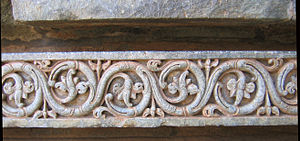
Back Rollwerk German Rollwerk Spanish Girale Italian 唐草模様 Japanese Rolwerk Dutch Rollwerk Polish Рольверк Russian 蔓草纹 Chinese





Key: *E: Ara Pacis, sculpture, c. 27 AD *B: Palazzo Mattei, Rome, stucco relief, 2nd century *D: Lateran, Rome, SS. Rufinus & Secundus, mosaic, 4th century *A: Dome of the Rock, Jerusalem, mosaic, 691-2 *C: San Clemente, Rome, mosaic, c. 1200
The scroll in art is an element of ornament and graphic design featuring spirals and rolling incomplete circle motifs, some of which resemble the edge-on view of a book or document in scroll form, though many types are plant-scrolls, which loosely represent plant forms such as vines, with leaves or flowers attached. Scrollwork is a term for some forms of decoration dominated by spiralling scrolls, today used in popular language for two-dimensional decorative flourishes and arabesques of all kinds, especially those with circular or spiralling shapes.
Scroll decoration has been used for the decoration of a vast range of objects, in all Eurasian cultures, and most beyond. A lengthy evolution over the last two millennia has taken forms of plant-based scroll decoration from Greco-Roman architecture to Chinese pottery, and then back across Eurasia to Europe. They are very widespread in architectural decoration, woodcarving, painted ceramics, mosaic, and illuminated manuscripts (mostly for borders).
In the usual artistic convention, scrolls "apparently do not succumb to gravitational forces, as garlands and festoons do, or oppose them, in the manner of vertically growing trees. This gives scrolls a relentless power. Even if attached to walls, they are more deeply embedded in the architectural order than the festoon, which are fictitiously hanging on them."[2]
- ^ Drawings based on illustrations in Rice, David Talbot, Byzantine Art, 3rd edn 1968, Penguin Books Ltd, plates 109-115
- ^ Necipoğlu, Gülru, Payne, Alina, Histories of Ornament: From Global to Local, 92, 2016, Princeton University Press, ISBN 0691167281, 978069116728, google books
© MMXXIII Rich X Search. We shall prevail. All rights reserved. Rich X Search